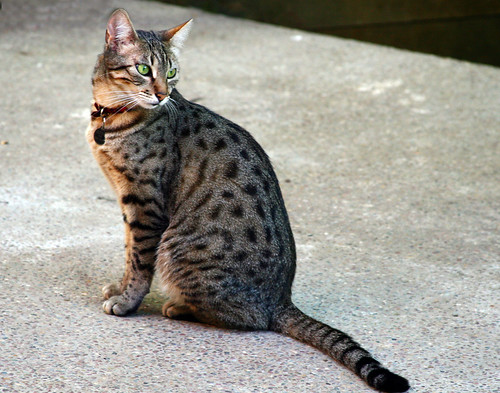
Egyptian Mau by Muffet
Egyptian Maus are a medium-large sized short-haired cat breed. They are the only naturally spotted breed of domesticated cat. The spots on an Egyptian Mau are not only just on the coat; a shaved Mau does, in fact, have spots on its skin. The spotted Mau is an ancient breed from natural stock; its look has not changed significantly as is evidenced by artwork over 3000 years old. Unlike other spotted cats such as the Ocicat or Bengal cat, the Egyptian Mau is a natural breed. Other breeds are created from domestic breed outcross or, in the case of the Bengal cat, domestic outcrosses with wildcats. The Mau is significantly smaller than these other breeds. The breed conformation is described by The Cornell Book of Cats as
a balance between the compactness of a Burmese and the slim elegance of a Siamese. Its medium-length body is muscular, with the hind legs longer than the front, giving the Mau the appearance of standing on tiptoes when upright.
The Egyptian Mau is the fastest of the domestic cats, with its longer hind legs, and unique flap of skin extending from the flank to the back knee, provides for greater agility and speed. Maus have been clocked running over 30 mph (48 km/h).
Maus often possess very musical voices. They are known to chirp, chortle and emit other distinctly unusual vocalizations when stimulated.
Another behavior, quite common in happy Maus, has been described as "wiggle-tail." The cat, male or female, moves its back legs up and down, and appears to be marking territory, also known as spraying, but it is not actually releasing urine. Even veteran Mau owners are known to check after a joyous Mau does this little dance.
The exact origin of the Egyptian Mau is not recorded and therefore cannot be known for certain. The Egyptian Mau is often said to be descended from African wild cats, and a descendant of the cats seen in wall paintings of Ancient Egypt.
The modern Mau is said to have originated in 1953, Italy, when exiled Russian Princess Natalie Troubetskoy met the cat of the Egyptian Ambassador to Italy. She convinced him to obtain several cats from Egypt for her, and she began to breed them. From her the Mau has been described as having a "troubled" look, with their round eyes and open expression. The Mau achieved championship status in some organisations in 1968. There were attempts by British breeders to create Maus from cross-breeds of Abyssinians, Siamese and tabbies, however these did not resemble the true Maus. This mix became the basis for the Ocicat.
Egyptian Maus will either have a 'scarab beetle' or 'M' marking on their foreheads, those with the latter tend to be from the United States.
a balance between the compactness of a Burmese and the slim elegance of a Siamese. Its medium-length body is muscular, with the hind legs longer than the front, giving the Mau the appearance of standing on tiptoes when upright.
The Egyptian Mau is the fastest of the domestic cats, with its longer hind legs, and unique flap of skin extending from the flank to the back knee, provides for greater agility and speed. Maus have been clocked running over 30 mph (48 km/h).
Maus often possess very musical voices. They are known to chirp, chortle and emit other distinctly unusual vocalizations when stimulated.
Another behavior, quite common in happy Maus, has been described as "wiggle-tail." The cat, male or female, moves its back legs up and down, and appears to be marking territory, also known as spraying, but it is not actually releasing urine. Even veteran Mau owners are known to check after a joyous Mau does this little dance.
The exact origin of the Egyptian Mau is not recorded and therefore cannot be known for certain. The Egyptian Mau is often said to be descended from African wild cats, and a descendant of the cats seen in wall paintings of Ancient Egypt.
The modern Mau is said to have originated in 1953, Italy, when exiled Russian Princess Natalie Troubetskoy met the cat of the Egyptian Ambassador to Italy. She convinced him to obtain several cats from Egypt for her, and she began to breed them. From her the Mau has been described as having a "troubled" look, with their round eyes and open expression. The Mau achieved championship status in some organisations in 1968. There were attempts by British breeders to create Maus from cross-breeds of Abyssinians, Siamese and tabbies, however these did not resemble the true Maus. This mix became the basis for the Ocicat.
Egyptian Maus will either have a 'scarab beetle' or 'M' marking on their foreheads, those with the latter tend to be from the United States.